As of today, July 27, the law on the decolonization of toponymy comes into force. What does it regulate, how should local governments carry out the process of renaming?
Three hundred years of russia’s domination over Ukrainian lands aimed to erase the national identity of Ukrainians. The streets of our cities and villages have become “pantheons” honoring the memory of those who had no connection to Ukraine, or even were hostile towards it and its people.
But times are changing. Ukrainians have a demand for the derussification of space, not least because of the large-scale attack by russia. The local authorities, for their part, are working on it.
Thus, throughout 2022–2023, 42 city councils out of 50 studied by the Transparent Cities program renamed 3,225 toponyms. Kyiv, Kramatorsk, Vinnytsia, Kremenchuk, and Sumy are the most active in terms of decolonization. Vinnytsia and Mukachevo city councils have announced they have already completed the decolonization of toponyms, and in Kolomyya, proposals of residents on names that have no informative, historical, or memorial value are collected.
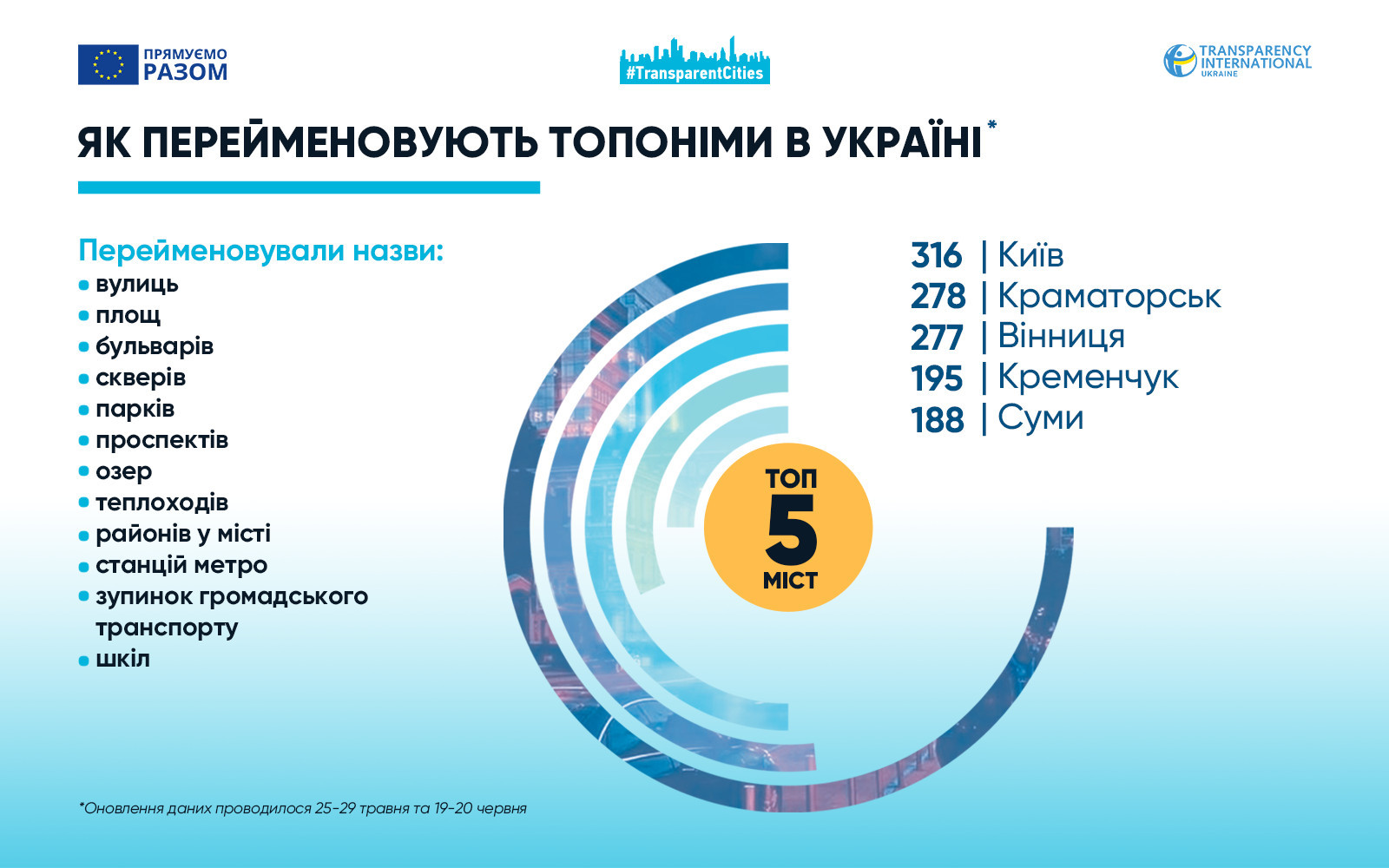
What are the key stages that all of our cities need to go through to change the names of toponyms? Which bodies take part in these processes, and what are their responsibilities? What will eventually change with the new law?
Renaming is easy and fast (spoiler: no)
To begin with, decolonization is generally used as a collective concept. It concerns both decommunization — the ban on symbols of communist ideology, and derussification — the rejection of the symbols of the Russian Empire and russia.
Local self-government bodies (LSGBs) — city, village, and settlement councils — are responsible for stripping the public space of Russian, Soviet, and imperial toponyms. After consultation with the public and experts, they should vote for new names for streets, alleys, boulevards, squares, avenues, embankments, and districts in cities.
However, residents can and should take the initiative. They can:
- submit a petition (template) demanding to rename toponyms, cancel the decision to rename toponyms, or initiate reconsideration of names for individual objects;
- instruct council members to put the issue of renaming certain toponyms on the agenda for consideration / reconsideration;
- submit a local initiative requesting to rename urbanonyms (city toponyms) or reconsider “problematic” names.
We and the Transparent Cities team described in detail how LSGBs should take such measures in a special Guide to the Decolonization of Ukrainian Cities.
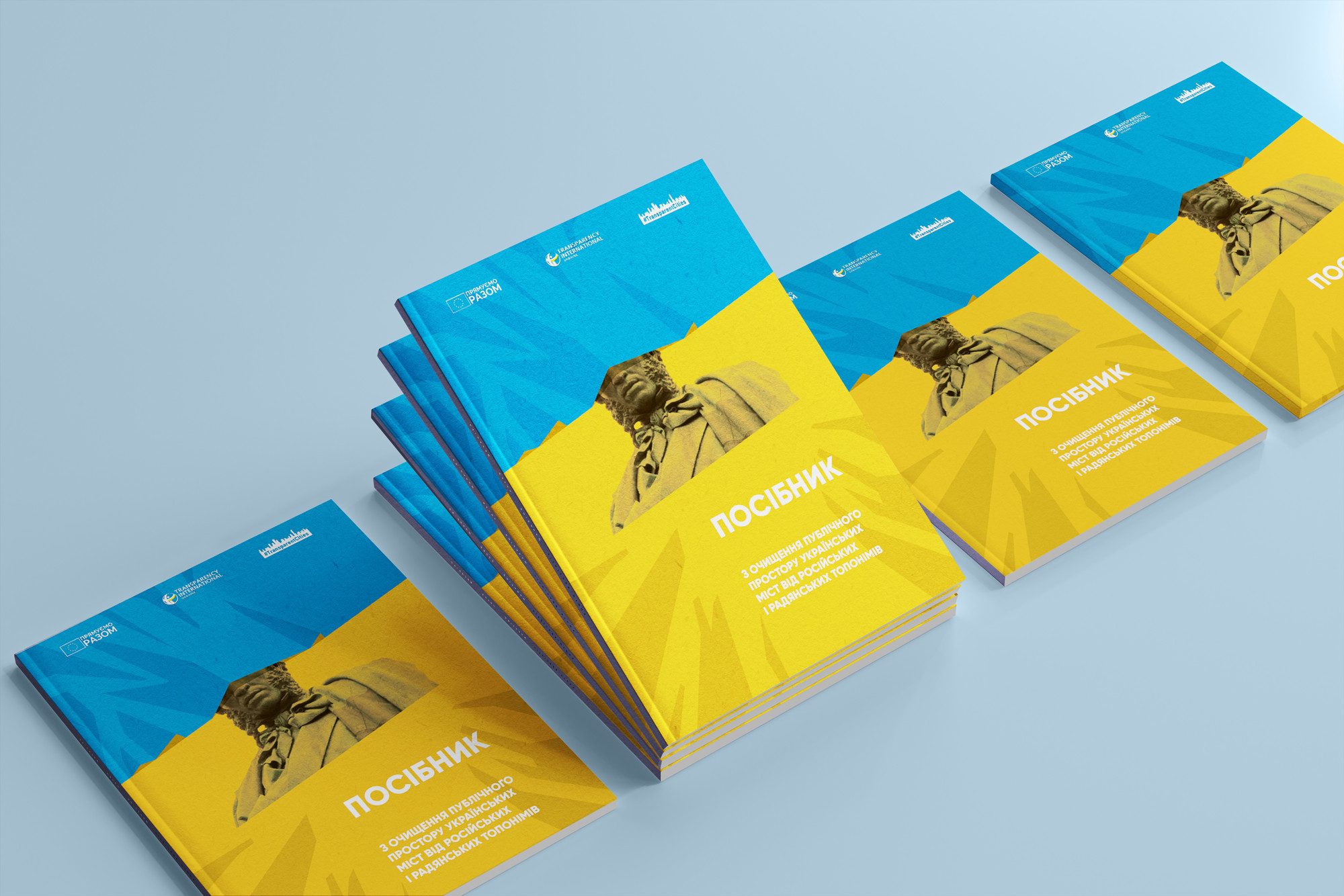
For each of these processes, there is a separate regulatory framework that records the responsibilities of local authorities and sets restrictions on certain names.
The Law of Ukraine “On Ensuring the Functioning of the Ukrainian Language as the State Language” regulates the correspondence of toponyms to Ukrainian spelling, in particular, when it comes to renaming the Russified toponyms — Arbuzynka, Nadezhdivka, Luch.
The so-called law on decommunization obliges local self-government bodies to rename toponymic and geographical objects, whose names contain symbols of the communist totalitarian regime. As of July 27, the Law of Ukraine “On the Condemnation and Prohibition of Propaganda of Russian Imperial Policy in Ukraine and Decolonization of Toponymy” is added to the existing legislation. It prohibits publicly honoring and promoting names with symbols of Russian imperial policy, its landmarks, memorable, historical, and cultural places, settlements, dates, events, and representatives.
We at Transparency International Ukraine expect that the law on decolonization of toponyms will accelerate this process. After all, local self-government bodies should change the names of toponyms that are still symbols of Russian imperial policy within six months from the date of entry into force of this law.
Once again: as of January 27, 2024, there should be no Russian, Soviet, or imperial toponyms in Ukraine. Of course, so far, we are talking about the unoccupied part of our country.
Step-by-step guide to clear urban spaces
The process of renaming toponyms in the context of the powers and responsibilities of LSGBs can be divided into several stages: We suggest taking a closer look at each of them.
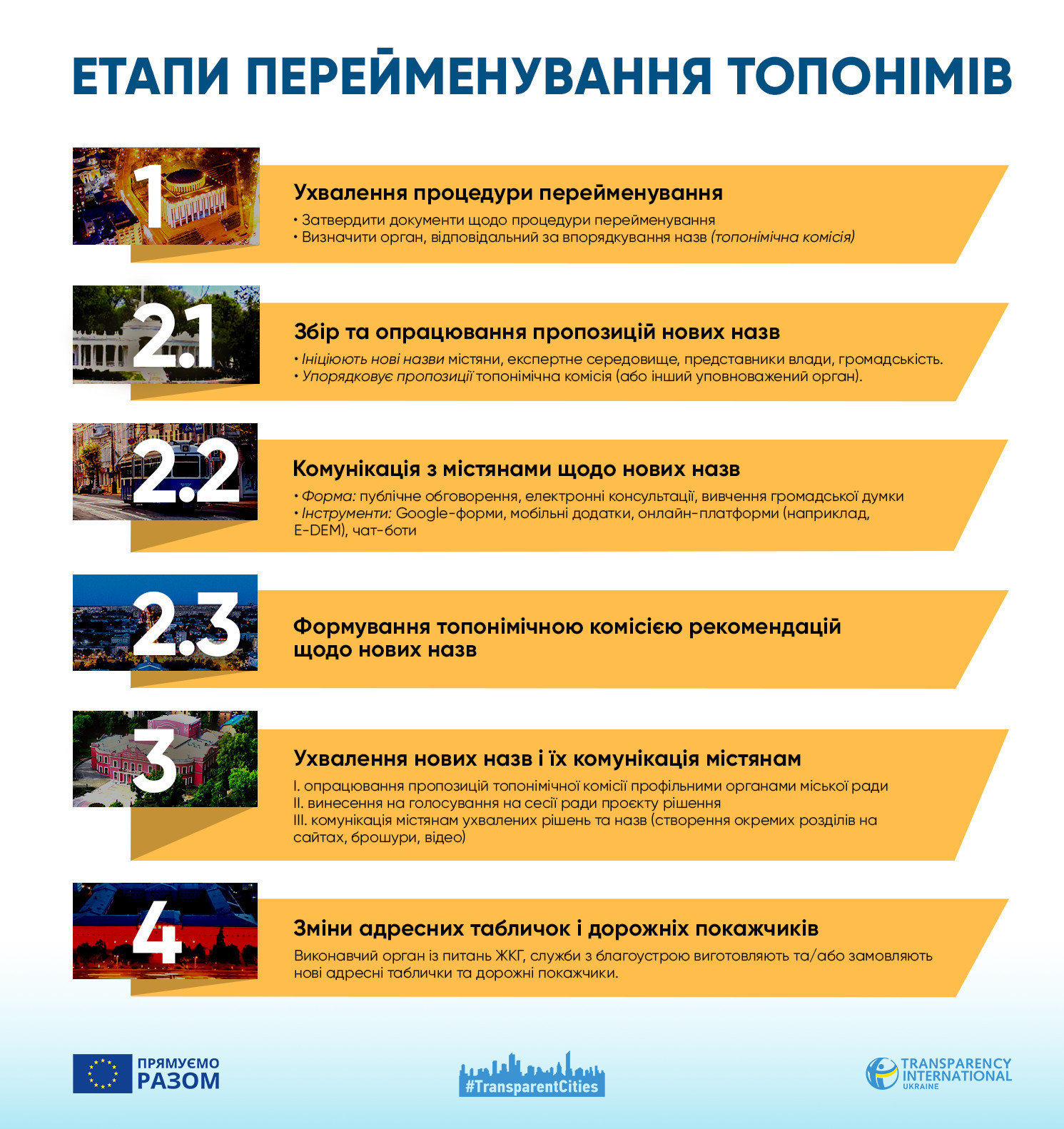
Stage 1: Adoption of the renaming procedure
Before starting the decolonization process, we call on local councils to adopt a document providing for the procedure to rename toponymic objects, as well as to determine the authority responsible for the regulation of toponyms (toponymic commissions), vested with advisory functions. This is a document that, in particular, details the powers of the commission.
For example, Lviv and Mykolaiv city councils have such documents. Kropyvnytskyi developed a separate Regulation on the city toponymic commission under the executive committee.
It is important that the public (academics and activists) be represented by at least half of the commission!
Stage 2: Collection and processing of proposals
– Formation of a list of names to be changed (as well as monuments to be dismantled) by the toponymic commission
– Communication with citizens regarding new names
Conducting public consultations will allow choosing the most appropriate version of the name that will meet the request of residents or the historical features of the area. This can be a public discussion, electronic consultations, or public opinion research. They need to be conducted within 30 calendar days.
– Formation of recommendations for new names by the toponymic commission
In the future, these recommendations should be processed by the relevant standing commissions of the council and the executive bodies of the city council.
Stage 3: approval of new names and their communication to citizens
After the specialized bodies have processed proposals for the new names of toponyms, a draft decision on renaming toponyms is submitted for the meeting of the city council. In case of a successful voting, we recommend that city councils properly communicate the new names.
For example, information can be posted on the website of the city council — as in the case of the Kropyvnytskyi City Council. The Sumy City Council publishes short videos about new toponyms, and a brochure including all the new names was created in Kyiv.
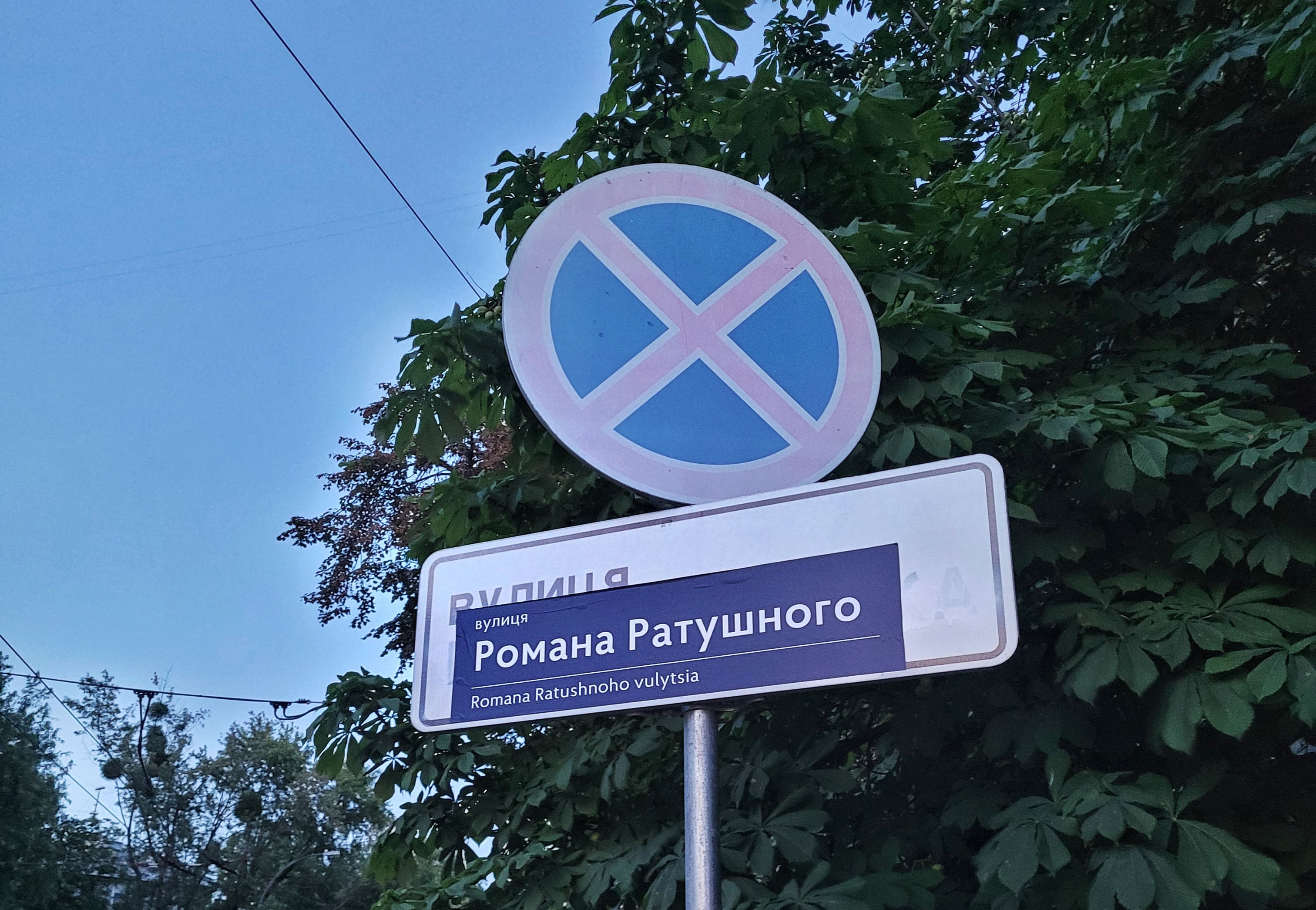 Photo: Viktoriia Karpinska
Photo: Viktoriia Karpinska
Stage 4: changing address plates and road signs
After the approval of the new names, the city council instructs the executive body for housing and municipal services and landscaping services to produce and order address plates and road signs, as well as plates for metro stations and stops.
It is important to note that the process of decolonization of toponyms does not oblige residents to change documents, such as the place of registration or ownership of real estate (unless the property is sold or leased). To do this, the executive body of the local council can obtain a certificate of renaming the street and use it when performing notarial acts.
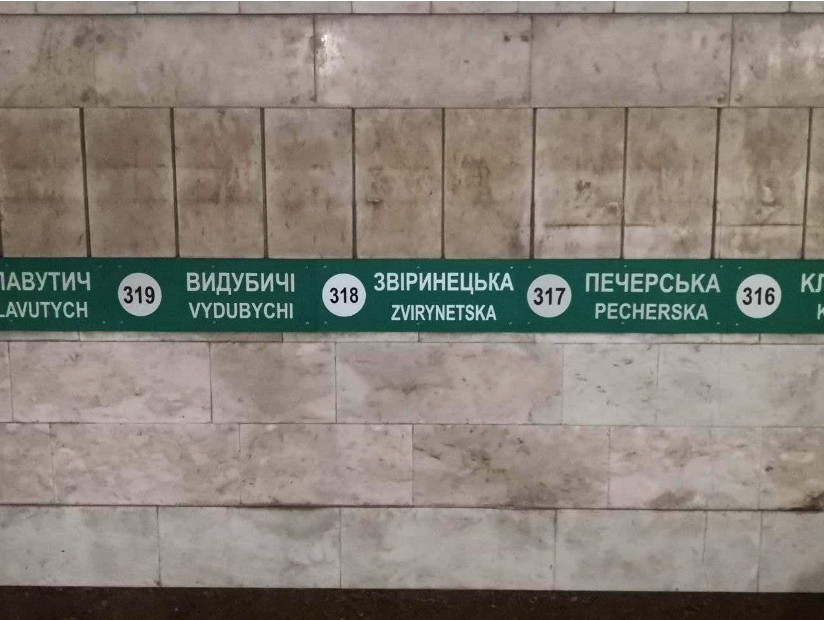 New information sign, Zvirynetska metro station instead of Druzhba Narodiv (Friendship of Peoples). Source: ME Kyiv Metro
New information sign, Zvirynetska metro station instead of Druzhba Narodiv (Friendship of Peoples). Source: ME Kyiv Metro
As of January 27, 2024, there should be no Russian, Soviet, or imperial toponyms in Ukraine.
And finally: renaming toponyms is not only about fulfilling the requirements of the law or about changing some address plates to others. The key idea of this process is to fill the streets of our cities with new meanings and values, and to honor those who fought for the Ukrainian State and glorified it with their actions.
Source: glavcom.ua
Currently, cities are faced with the task of deciding on the renaming of toponyms associated with russia. This process might be met with resistance on the part of the citizens, and the authorities will need to make an additional effort to explain why it is important to decolonize toponyms. In other cases, residents might have to put pressure on local authorities to rename those streets, squares, or boulevards that symbolize the empire. Be that as it may, choosing the most successful version of the new name, which will meet the public demand or the historical features of the area, is impossible without a dialogue between the authorities and the community.